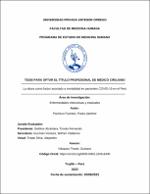La altura como factor asociado a mortalidad en pacientes COVID-19 en el Perú
Abstract
Determinar si la altura es un factor asociado a mortalidad en pacientes COVID-19 en el territorio peruano. Materiales y métodos: Estudio observacional de casos y controles analítico de base de datos secundaria. Se midió la asociación de la altura y la mortalidad mediante Chi cuadrado X2 de Pearson y análisis multivariado con regresión logística simple y múltiple controlando las variables edad, sexo, severidad y comorbilidades con IC 95%. Resultados: Se analizaron los datos de 616 382 pacientes durante la segunda ola en 26 regiones del Perú (47,7% de sexo femenino y 52,3% de sexo masculino) siendo la edad promedio 42,7 ± 18,2 años. La comorbilidad más frecuente fue la enfermedad cardiovascular (4,5%) y el síntoma más frecuente fue la tos (65,2 %). Las tasas de mortalidad más altas se registraron en las macrorregiones de Lima/Callao y Norte con 157 y 131/100 000 respectivamente. En el análisis bivariado la edad, sexo, grado de severidad y comorbilidades fueron significativas (p<0,001; IC 95%) por lo que entraron al análisis multivariado de regresión logística múltiple, donde se observa que residir entre 2 000-3 000 y 4 000-5 000 m s.n.m. tiene un 62% y 32 % menos probabilidad de muerte en comparación con la población que reside a menos de 1000 m s.n.m.; IC 95% OR: 0,38 (0,36 - 0,40) y OR 0,68 (0,59 - 0,80) respectivamente. En la regresión logística simple los paciente que viven entre 2 000-3 000 m s.n.m. tienen 68% menos probabilidad de morir respecto a la población que vive a menos de 1 000 m.s.n.m. OR: 0,32 (IC 95% 0,31 - 0,34). Conclusión: En la población peruana residir a más de 1 000 m s.n.m y 2 300 m s.n.m constituye un factor de protección frente a la muerte por COVID-19. To determine whether altitude is a factor associated with mortality in COVID-19 patients in Peru. Materials and methods: Observational case-control study analyzing secondary database. We measured association with Chi-square X2 and multivariate analysis with simple and multiple logistic regression controlling for age, sex, severity and comorbidities (95%CI). Results: We analyzed data from 616382 patients during the second wave in 26 regions of Peru (47.7% female and 52.3% male) with an average age of 42.7 ± 18.2 years. The most frequent comorbidity was cardiovascular disease (4.5%), the most frequent symptom was cough (65.2%). The highest mortality rates were recorded in the macro-regions of Lima/Callao and the North with 157 and 131/100 000 respectively. In the bivariate analysis, age, sex, degree of severity and comorbidities were significant (p<0.001; 95% CI) and therefore entered the multivariate analysis of multiple logistic regression, where it was observed that residing between 2 000-3 000 and 4 000-5 000 m asl has a 62% and 32% lower probability of death compared to the population residing at less than 1 000 m asl; 95%CI OR: 0.38 (0.36-0.40) and OR 0.68 (0.59-0.80) respectively. In the simple logistic regression, patients living between 2 000-3 000 m asl were 68% less likely to die compared to the population living below 1000 m asl OR: 0.32 (CI 95% 0.31-0.34). Conclusion: In the Peruvian population, residing above 1 000 m asl and 2 300 m asl is a protective factor against death from COVID-19.
Subject
Collections
- Medicina Humana [2969]


